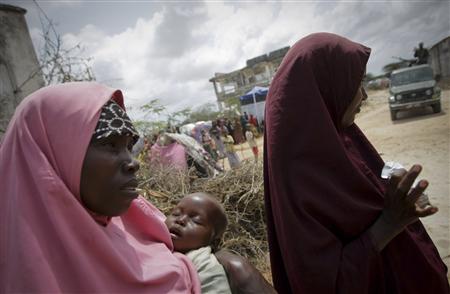Michel Chossudovsky, Global Research, July 21, 2011
For the last twenty years, Somalia has been entangled in a “civil war” amidst the destruction of both its rural and urban economies.
The country is now facing widespread famine. According to reports, tens of thousands of people have died from malnutrition in the last few months. The lives of several million people are threatened.
The mainstream media casually attributes the famine to a severe drought without examining the broader causes.
An atmosphere of “lawlessness, gang warfare and anarchy” is also upheld as one of the major causes behind the famine.
But who is behind the lawlessness and armed gangs?
Somalia is categorized as a “failed state”, a country without a government.
But how did it become a “failed state”? There is ample evidence of foreign intervention as well as covert support of armed militia groups. Triggering “failed states” is an integral part of US foreign policy. It is part of a military-intelligence agenda.
According to the UN, a situation of famine prevails in southern Bakool and Lower Shabelle, areas in part controlled by Al Shahab, a jihadist militia group affiliated to Al Qaeda.
Both the UN and the Obama administration had accused Al Shahab of imposing “a ban on foreign aid agencies in its territories in 2009”. What the reports do not mention, however, is that Harakat al-Shabaab al-Mujahideen (HSM) (“Movement of Striving Youth”) is funded by Saudi Arabia and supported covertly by Western intelligence agencies.
The backing of Islamic militia by Western intelligence agencies is part of a broader historical pattern of covert support to Al Qaeda affiliated and jihadist organizations in a number of countries, including, more recently, Libya and Syria.
The broader question is: What outside forces triggered the destruction of the Somali State in the early 1990s?
Somalia remained self-sufficient in food until the late 1970s despite recurrent droughts. As of the early 1980s, its national economy was destabilized and food agriculture was destroyed.
The process of economic dislocation preceded the onset of the civil war in 1991. Economic and social chaos resulting from IMF “economic medicine” had set the stage for the launching of a US sponsored “civil war”.
An entire country with a rich history of commerce and economic development, was transformed into a territory.
In a bitter irony, this open territory encompasses significant oil wealth. Four US oil giants had already positioned themselves prior to the onset of the Somali civil war in 1991:
Far beneath the surface of the tragic drama of Somalia, four major U.S. oil companies are quietly sitting on a prospective fortune in exclusive concessions to explore and exploit tens of millions of acres of the Somali countryside.
According to documents obtained by The Times, nearly two-thirds of Somalia was allocated to the American oil giants Conoco, Amoco, Chevron and Phillips in the final years before Somalia’s pro-U.S. President Mohamed Siad Barre was overthrown and the nation plunged into chaos in January, 1991. …
Officially, the Administration and the State Department insist that the U.S. military mission in Somalia is strictly humanitarian. Oil industry spokesmen dismissed as “absurd” and “nonsense” allegations by aid experts, veteran East Africa analysts and several prominent Somalis that President Bush [Senior], a former Texas oilman, was moved to act in Somalia, at least in part, by the U.S. corporate oil stake.
But corporate and scientific documents disclosed that the American companies are well positioned to pursue Somalia’s most promising potential oil reserves the moment the nation is pacified. And the State Department and U.S. military officials acknowledge that one of those oil companies has done more than simply sit back and hope for peace.
Conoco Inc., the only major multinational corporation to maintain a functioning office in Mogadishu throughout the past two years of nationwide anarchy, has been directly involved in the U.S. government’s role in the U.N.-sponsored humanitarian military effort.( The Oil Factor in Somalia : Four American petroleum giants had agreements with the African nation before its civil war began. They could reap big rewards if peace is restored. – Los Angeles Times 1993)
Somalia had been a colony of Italy and Britain. In 1969, a post-colonial government was formed under president Mohamed Siad Barre; major social programs in health and education were implemented, rural and urban infrastructure was developed in the course of the 1970s, significant social progress including a mass literacy program was achieved.
The early 1980s marks a major turning point.
The IMF-World Bank structural adjustment program (SAP) was imposed on sub-Saharan Africa. The recurrent famines of the 1980s and 1990s are in large part the consequence of IMF-World Bank “economic medicine”.
In Somalia, ten years of IMF economic medicine laid the foundations for the country’s transition towards economic dislocation and social chaos.
By the late 1980s, following recurrent “austerity measures” imposed by the Washington consensus, wages in the public sector had collapsed to three dollars a month.


